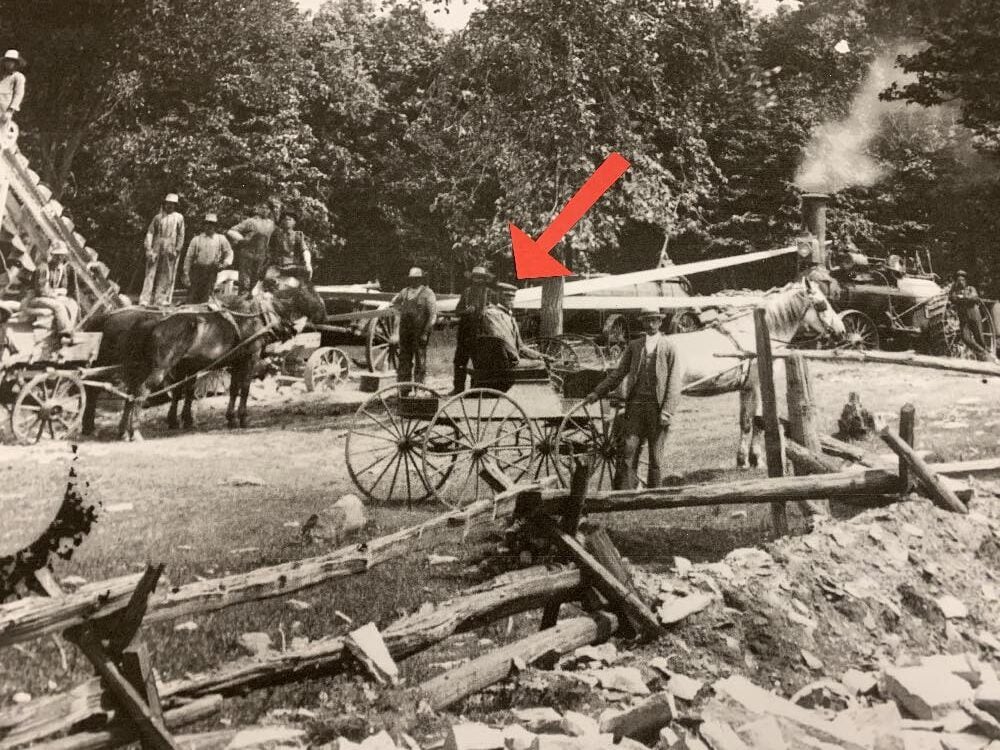In 2022, the Rev. Canon Hilary Murray proposed that she and the Archivist work together on an exhibit to mark the presence of Black Anglicans in the Anglican Diocese of Ottawa. They soon agreed to create a cycle of exhibits to cover the 242 years that Black Anglicans have resided in this region. They divided this time period into five sections.
They began with the period 1929-1977—a time during which the first Black person, Blair Dixon, was ordained an Anglican priest in the Diocese (1966). In 2023, they focused on the first swath of time in the cycle, 1784-1832, when the first Black Anglicans are recorded being baptized and married in Anglican parishes here, some of them either arriving as enslaved persons or escaping the institution of slavery in the U.S. In 2024, the focus was on the next time period, 1833 to 1880, noting the under-reporting of the Black presence at a time when the memory of slavery was omnipresent, while the U.S. Civil War raged, and Reconstruction began.
This year, our focus is the period falling between 1881 and 1928. It started only 20 years after the Emancipation Proclamation was made in the U.S., and just when Reconstruction was effectively being shut down in the southern U.S. Of the five periods examined in our project, it is the most curious due to the lack of regional information and photographs and the surprising fact that during this time some Blacks began returning to the U.S.
The 81 Black inhabitants of the Diocese of Ottawa listed in the 1911 census (this number may also be under-reported)—like all Blacks in North America—were haunted by the legacy of slavery. They lived at a time when much of the population in eastern Ontario and western Quebec was migrating west to the opening prairie provinces.
Although slavery had been legislated out of existence, first in the British Empire and later in the United States, it left Blacks in an economically disadvantaged position in North America. The rise of the Ku Klux Klan from the 1860s on saw many former slave states enact laws that enforced segregation. Blacks were exploited at the lowest wages as a matter of course, and news of lynchings terrified them. Those migrating north to U.S. cities closer to Canada occupied the lowest rungs on the economic ladder.
Canada had long prided itself on being a haven for those escaping from slavery in the U.S. from the 1830s to the early 1860s. But, as James W. StG. Walker wrote in his book Racial Discrimination in Canada: The Black Experience, even as the Underground Railway was celebrated in touring productions of Harriet Beecher Stowe’s anti-slavery two-volume novel Uncle Tom’s Cabin; or, Life Among the Lowly, which was published in 1852—visiting even the smallest hamlets in the region—it underlined the continuing low economic status of Blacks in North American society.
Prevailing race theory and the racist stereotyping of Blacks in print media, and notably in the 1916 silent film Birth of a Nation, reinforced negative stereotypes of Blacks. “The ideology of racism came from outside Canada, but it landed on fertile soil,” Walker wrote. The following excerpts from his book paint a vivid picture of the racism Blacks faced in Canada during this era:
“White Canadians could identify with the European rulers of overseas empires, finding in themselves the same virtues which led European civilization to dominate much of the globe…
“It was this intellectual environment that was met by the first large body of American Blacks to enter Canada since Confederation. Among the six hundred thousand Americans attracted by the Canadian immigration recruitment campaign were a few Blacks, but it was the deterioration of conditions for blacks in Oklahoma, following statehood in 1907, that produced a wider movement into Canada. Already experienced with farming techniques useful on the prairies, and encouraged by immigration literature, approximately thirteen hundred Blacks from Oklahoma settled in Alberta and Saskatchewan between 1910 and 1912…. Their numbers, and the fear that this was the first wave in a potential flood of black migrants, brought demands for special legislation to preserve the West for whites only….
“Public petitions and municipal resolutions from all three prairie provinces urged Ottawa to ban further Black immigrants and to segregate those already there….Newspapers in Toronto, Ottawa and Montreal supported Western resolutions, citing the American example as “proof” that Blacks were inferior and disruptive, and similar sentiments were expressed in federal parliament.
“The Liberal government prepared an order-in-council in 1911 to prohibit Black immigration for one year, but it was never proclaimed. Fear that relations with the United States could be damaged, and that Black voters in Ontario and the Maritimes would be alienated apparently prevented such an overt restriction. Instead, less formal measures were adopted. Agents were sent into the South to discourage black migrants: medical, character, and financial examinations were rigorously applied at border points, with rewards for officials who disqualified Blacks; American railways were influenced to deny Blacks passage to Canada. Continued by the Conservatives after their 1911 election victory, this subtle campaign had stopped all black immigration by 1912 without the necessity of ever declaring a formal racist policy.
“Similar attitudes excluded Blacks from participation in mainstream activities all across Canada. This was demonstrated dramatically during the First World War. Anxious to do their part for nation and empire, young Black men volunteered for overseas service. Though no blanket restriction was imposed, individual commanding officers were entitled to refuse Black volunteers, and most did so….
“Blacks were concentrated in specialized corners of the inter-war economy, the men as waiters, janitors, barbers and labourers, and the women as domestic servants, laundresses, and waitresses. The elite among the men worked as railway waiters and porters. This range shrank as difficult economic circumstances displaced white workers, so that waiting jobs and other personal contact positions passed increasingly to whites. The Blacks’ near-monopoly of railway service was breached when the position of dining-car waiter became a white preserve, leaving blacks as sleeping-car porters with no opportunity for promotion to senior roles.
“The persistent notion that blacks belonged apart denied them admission to many recreational facilities, including dance halls, swimming pools, skating rinks, theatres, and hotels. Although there was no absolute barrier, for local practices varied considerably, the restrictions consistently reflected a belief that white superiority could be undermined by intimate contact. Attempts to entrench segregation through formal laws during the 1920s were unsuccessful, but discriminatory practices were upheld in the courts as legally acceptable. In 1919 the Quebec Appeal Court declared it legal for Loew’s Theatre in Montreal to continue its practice of restricting Blacks to balcony seats. Ontario courts in 1934 found it legal for a restaurant to deny service on grounds of race.”
Next year, we will focus on the most recent phase, the years 1978 to 2026, when the numbers of Black Anglicans increased exponentially and a number of Black clergy began serving parishes in the Diocese of Ottawa.


St. James, Morrisburg — Stormont Deanery